
Transcription
Växjö UniversitySchool of HumanitiesEnglish sectionENC 160Fall term 2005Supervisor: Maria OlaussenCatharsis in Yvonne Vera’s Butterfly BurningErika Borg
Table of contentsIntroduction1Catharsis – definition and brief history2Aim and approach4Secondary sources4Chapter OneThe symbolism of music, words, dance and silence6Music and living conditions7Music and the mechanic rhythm of work8Words in a song9Dance11Rhythm of the text12Chapter TwoThe symbolism of natural phenomena14Water, light and dry land14Fire, ground and light17Conclusion21References23
IntroductionYvonne Vera’s novel, Butterfly Burning is about search for catharsis, for the triumph ofhealing and beauty over wounds and chaos. The novel breaks the silence imposed bycolonialism on the people in Zimbabwe. It gives voice to the silent pain of the living and itweeps for the dead who gave their life resisting oppression. At the same time, the book givesvoice to joy and celebration, through which the people survive and resist their restrictiveliving conditions.Butterfly Burning is closely connected to colonialism and historical reality.However, it surpasses these boundaries through its protagonist, a young African woman,Phephelaphi. The reader is invited to witness Phephelaphi’s tragic endeavour to achieveintegrity and independence, an endeavour that can be regarded as a universal problem thatprobably many women face irrespective of ethnic or historical background.The boundaries of ethnicity and history are surpassed also through therepresentation of pain and joy. What makes this novel great is Vera’s unique way of renderinglived experience through written words. She describes pain in such a way that it hurts; shedepicts celebration in such a manner that one wishes to join in. Through her literarypresentation, Vera brings to the surface basic human experiences that link people irrespectiveof race, country or the time they have lived in.I feel the great power of Butterfly Burning emerge from the symbolism of thelanguage. Through recurrent motifs, metaphors and symbols, Vera creates a meta-world orrather an aura to reality consisting of light, sounds and a multitude of various elements ofnature. She evokes the sounds of music and songs. Then she represents silence as well, whichmakes the sounds even more precious. In addition, she creates a constant play of light andcolours, which emanate or reflect from water, river, soil and, most of all, from people. Thevarious natural phenomena or elements of nature are a living presence in this world; theysurround and represent people. Consequently, every feeling and experience receives universaldimensions. Furthermore, through symbols, the boundary between human and non-human isremoved and a certain harmony is created, in which everything is connected and is “natural”.In this togetherness with nature, even death can be seen in a different light, death meaning notthe end of life, but merely its metamorphosis. Thus, through its recurrent motifs and symbols,the novel transmits simultaneously a sense of pain or horror and their opposite, the sensationof relief, joy and beauty.- -1
For me as a reader, the moments of joy and beauty are essential as they offer anecessary counterpoint to the immense pain that the story evokes. Referring to relief, joy andbeauty, I am going to use the term catharsis. In my use of this term, I want to emphasize thenature of joy and beauty in Butterfly Burning, more specifically, their close connection totrauma and pain. There is no pure, unconditioned joy in this book, but joy despite sorrow,beauty despite horror. Among other things, this is what the concept catharsis comprises. In thefollowing section, I will present a more detailed explanation of this meaning and use ofcatharsis.Catharsis – definition and brief historyI use the term catharsis to refer to relief and beauty present in a literary text that deals withtrauma or some tragic experience. The word implies that relief and beauty emerge beside ordespite the sorrow and horror that the text represents. I derive this definition frominterpretations of Aristotle’s and Freud’s theories about catharsis, formulated in the articles:“Talking around Trauma: on the Relationship Between Trauma, Narration, and Catharsis inLiterature” by Sven Kramer and “Trauma Within the Limits of Literature” by GeoffreyHartman. In the following paragraphs, I am going to sum up a few of the ideas shared bythese critics.Catharsis is a literary term introduced by Aristoteles in his Poetica, a workformulating his concept on tragedy as a dramatic genre. Here, Aristotle defines catharsis as “acleansing of affect by means of pity (eleos) and fear (phobos)” (Kramer 1) which the tragicheroes evoke through their fate. Aristotle’s initial theory linked to drama has been interpretedby various critics and applied to other literary genres dealing with tragedy. To summarizethese interpretations, catharsis has been defined as relief from destructive emotions throughappreciation of an aesthetic experience. The definition emphasizes the role of the artisticdevices in evoking catharsis. It is implied that the sense of relief issues from or is the merit ofthe creative literary representation of tragedy.The concept of catharsis has been defined and used in psychoanalysis as well. Ina work entitled Studies on Hysteria, Freud connects catharsis to trauma, a psychic woundbrought about by painful experiences. Located in the unconscious, a region inaccessible to thewill of the patient, this wound causes various disorders and mental pain to the traumatised.According to Freud, a means of curing the wound is language; more specifically, putting badexperiences into words has a relieving effect. The process of relieving mental confusion and- -2
pain through linguistic verbalisation was called catharsis by Freud. As a result of his research,Freud also made observations on the difficulties of approaching severe traumatic experiences.Deep wounds tend to bereave people of words, he said, therefore no relief or curing ispossible for the severely traumatised.Trauma study in literature draws a parallel between the curative power ofpsychoanalytic verbalisation and the cathartic effect of linguistic representation in literature.In this respect, Sven Kramer points out that “many literary works have played an importantrole in bringing the submerged and on-going effects of social catastrophes to the surface ofour consciousness” (Kramer1). Here, Kramer underlines the great role of literature in offeringrelief from suffering by giving voice to tragic experiences.Geoffrey Hartman also emphasises the role of literature in creating catharsis andhe adds the idea that literature does not resign to the failure of words, but it continuouslychallenges silence. “If there is a failure of language, so that silence or mutism ensues, then noworking-through or catharsis is possible. Literary verbalization, however, is a basis formaking the wound perceivable and the silence audible. It is a sophisticated and delimitedreenactment.” (Hartman 5). Here, Hartman alludes to the special nature of literature, namely,to the power of artistic representation. It is implied that literature or literary verbalisation iseffective in creating catharsis thanks to its inherent artistic devices.In my paper, I am going to focus on both the psychoanalytic and the aestheticconnotations of the concept catharsis. Firstly, I am going to concentrate on catharsis in theFreudian sense, meaning relief from trauma through verbalisation of tragic experiences. Here,I am going to talk about Vera’s challenging of social taboos like abortion, suicide and violentdeath. Furthermore, I am going to reflect on catharsis in the Aristotelian sense, namely on thecreation of relief, joy and beauty through the creative or artistic representation of tragedy. Mymain focus is going to be the effect of various symbols in the novel. Catharsis both in theFreudian sense and the Aristotelian meaning are actually inherent in Vera’s text as a whole,including both the content and the form. In other words, catharsis manifests itself in the novelas a result of literary verbalisation or representation. It is the unique way of rendering thecontent through symbols and recurrent motifs that invites relief, joy and beauty besides ordespite sorrow and horror in Butterfly Burning.- -3
Aim and approachThe aim of my paper is to highlight some of the cathartic elements of Yvonne Vera’s ButterflyBurning. The main focus is going to be on the representation of relief and joy. As theseexperiences are closely connected to trauma and pain, emphasis is going to be laid on theevocation of tragedy as well. Special attention is going to be dedicated to the creation ofbeauty through artistic representation.I am going to approach my theme by looking at the use of a variety of recurrentsymbols and motifs in the novel. The focus is going to be on music, song, words, dance andrhythm as opposed to silence and stillness in the first part of my paper. Then, in the secondpart, I am going to discuss the symbolism of some natural phenomena, such as water, light,land, fire and soil.My research question is: How do symbols and recurrent motifs contribute toevoking catharsis in Yvonne Vera’s Butterfly Burning?Secondary sources:The voice of Vera’s Butterfly Burning has been highly acclaimed by critics in a variety ofarticles and lectures. In my paper, I am going to refer to some of these works as a basis or asupport for my analysis. The article, “Between the Pause and the Waiting: the StruggleAgainst Time in Yvonne Vera’s Butterfly Burning” by Violet Bridget Lunga deals with thecharacters’ struggle against their oppressive living conditions. The critic emphasizes the roleof music in creating a vital breathing space for the oppressed. In “Do You Hear What I Hear?:The Conflicts of Language in Nehanda”, Heather Sofield reflects on the symbolism andsignificance of the word in representing orality, a basic trait of Zimbabwean culture. Similarobservations are formulated by Kizito Zhiradzago Muchemwa in the article “Language, Voiceand Presence in Under the Tongue and Without a Name”. Here the critic discusses Vera’sgiving voice to the Zimbabwean woman’s silenced words and her recreation of repressed oraltraditions of the collective. Carolyn Martin Shaw’s article, “The Habit of Assigning Meaning:Signs of Yvonne Vera’s World” offers interpretations on the meaning and role of a variety ofrecurrent symbols and motifs in Vera’s creation. Shaw points to the complexity andcontradictoriness of Vera’s sign system, which gives rise to polyphonic meanings andunderstandings. Shaw also observes that through these symbols and signs Vera provokestraditional views on Zimbabwean people, especially on the woman. Lizzy Attree’s- -4
“Language, Kwela Music and Modernity in Butterfly Burning” focuses on the novel’soffering of enhanced aesthetic experience through the creative representation of music andrhythm. In an unpublished lecture about Butterfly Burning, Ashleigh Harris discusses thesignificance of music and dance in expressing resistance and “life force” in opposition tosuppression and death symbolised through silence in the novel. She also makes observationsabout Vera’s use of “images of beauty” around the representation of death. According toHarris, the role of these images is to capture the readers’ attention, to disarm their possiblereluctance to read about distressing topics like sorrow and death.- -5
Chapter OneThe symbolism of music, words, dance and silenceThe aim of this section is to show how the symbolism of music, song, and dance expresses asense of relief, joy and freedom against trauma, sorrow and suppression symbolised mainlythrough silence and stillness. Music is one of the most distinct recurrent motifs in ButterflyBurning, besides light and natural phenomena. It is present in the form of kwela, a specialtype of music created by the indigenous people in Southern Africa. Music is the symbol ofpeople’s creativity and life force. Also, it symbolizes freedom and resistance to oppression.This is going to be the topic of the first section of this chapter. In the second section, I amgoing to underline the contrast between music and the mechanical rhythm of work. To supportmy ideas, I am going to invoke literary critic Violet Bridget Lunga’s article, “Between thePause and the Waiting: the Struggle Against Time in Yvonne Vera’s Butterfly Burning”.The effect of music is intensified with the significance of words, which emergeas powerful elements in the novel. There is special focus on the words that create songs. Then,high emphasis is laid on the words uttered by characters. Articulation itself and the wordschosen to be uttered carry a special significance beyond their obvious meaning. They aresymbols of the people’s identity and strength. In this section, I am going to focus on the wordsthat create songs. Articulation and the words uttered are going to be dealt with in the secondpart of the paper. I am going to present a short summary of the article entitled “Do You HearWhat I Hear?: The Conflicts of Language in Nehanda” by Heather Sofield as an explanationof the social-historical significance of the word. Also, I am going to refer to Kizito Z.Muchemwa’s “Language, Voice and Presence in Under the Tongue and Without a Name”.Music and song is completed with dance and then all these are juxtaposed withsilence and stillness. The juxtaposition reinforces the symbolism of these elements’expression of the contrast between oppression and resistance, as well as, between trauma andcatharsis. This is going to be the topic of the next section. I am going to present a shortsummary of an unpublished lecture given by Ashleigh Harris as a support for my arguments.A further paragraph is going to be dedicated to the musicality of the text. Here, Iwill talk about the sense of musicality created through literary style or language. I am goin
Fall term 2005 Supervisor: Maria Olaussen Catharsis in Yvonne Vera s Butterfly Burning Erika Borg . Table of contents Introduction 1 Catharsis Πdefinition and brief history 2 Aim and approach 4 Secondary sources 4 Chapter One The symbolism of music, words, dance and silence 6 Music and living conditions 7 Music and the mechanic rhythm of work 8 Words in a song 9 Dance 11 Rhythm of











